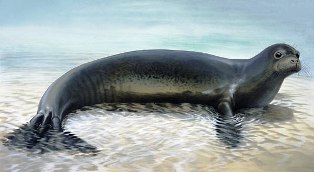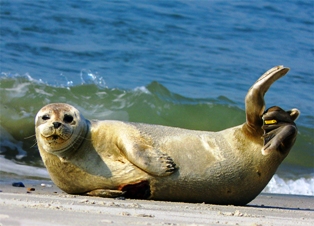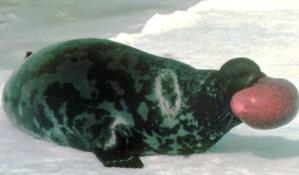Discover Florida Nature
It's time to explore the natural Florida


|
|
|
|
|
Seals live in the oceans of both hemispheres and are mostly confined to
polar, sub-polar, and temperate climates, with the exception of the more
tropical monk seals. True seals inhabit all oceans, except the Indian
Ocean. Some species live in inland lakes in Siberia, Russia, and
Finland. Seals forage, search for food, at sea, but haul out (get out of
the water) to land to breed, molt, or shed fur, and rest. Seals eat
mostly fish, but also feed on krill, squid, octopuses, and other seals.
True seals congregate on land or ice to breed and molt. The males and
females of some species migrate, travel, separately from breeding to
foraging areas, some traveling as far south as Florida. Others species
do not migrate.  Caribbean
Monk Seal- At one time, Caribbean, or West Indian, monk seals
inhabited the Caribbean Sea, northwest to the Gulf of Mexico, as well as
from the Bahamas to the Yucatan Peninsula, south along the Central
American coast and east to the northern Antilles. Some spottings around
the Florida coast also exist. The Caribbean monk seal was formally
declared extinct in 1996. The last reported sighting in 1952 was from
Seranilla Bank between Jamaica and Honduras, where a small colony was
known to have lived. The Caribbean monk seal was documented as being
easily approachable and not aggressive and they were easily killed
during directed hunts in the 17th and 18th centuries. It is also known
that sailors, whalers, and fishers opportunistically killed the seals
they encountered. As well, Caribbean monk seals were killed by museum
collectors and displayed in zoos. All monk seal species appear to be
sensitive to disturbance, and early habitat exclusion by humans
throughout their range may have exacerbated their decline. "Humans left
the Caribbean monk seal population unsustainable after overhunting
them," Kyle Baker, a biologist for the National Marine Fisheries
Service, said in a statement. "Unfortunately, this led to their demise
and labels the species as the only seal to go extinct from human
causes." A Caribbean monk seal, the only subtropical seal native to the
Caribbean Sea and Gulf of Mexico, had not been seen for more than 50
years. Very little scientific information was gathered before the
Caribbean monk seal disappeared. Males are thought to have reached a
length of 2.1 to 2.4 m; females may have been slightly smaller. The
backs of adult seals were brown with a grey tinge; the underside was
pale yellow, as was the muzzle. The fur of newborns was long and dark.
Evidence suggests that the pups were born in December weighing between
16 and 18 kg, and measuring up to 1 m in length. Caribbean
Monk Seal- At one time, Caribbean, or West Indian, monk seals
inhabited the Caribbean Sea, northwest to the Gulf of Mexico, as well as
from the Bahamas to the Yucatan Peninsula, south along the Central
American coast and east to the northern Antilles. Some spottings around
the Florida coast also exist. The Caribbean monk seal was formally
declared extinct in 1996. The last reported sighting in 1952 was from
Seranilla Bank between Jamaica and Honduras, where a small colony was
known to have lived. The Caribbean monk seal was documented as being
easily approachable and not aggressive and they were easily killed
during directed hunts in the 17th and 18th centuries. It is also known
that sailors, whalers, and fishers opportunistically killed the seals
they encountered. As well, Caribbean monk seals were killed by museum
collectors and displayed in zoos. All monk seal species appear to be
sensitive to disturbance, and early habitat exclusion by humans
throughout their range may have exacerbated their decline. "Humans left
the Caribbean monk seal population unsustainable after overhunting
them," Kyle Baker, a biologist for the National Marine Fisheries
Service, said in a statement. "Unfortunately, this led to their demise
and labels the species as the only seal to go extinct from human
causes." A Caribbean monk seal, the only subtropical seal native to the
Caribbean Sea and Gulf of Mexico, had not been seen for more than 50
years. Very little scientific information was gathered before the
Caribbean monk seal disappeared. Males are thought to have reached a
length of 2.1 to 2.4 m; females may have been slightly smaller. The
backs of adult seals were brown with a grey tinge; the underside was
pale yellow, as was the muzzle. The fur of newborns was long and dark.
Evidence suggests that the pups were born in December weighing between
16 and 18 kg, and measuring up to 1 m in length. Common
Seal- The common seal, also known as the harbor seal, is an
agile carnivore with a streamlined body and flipper-like limbs that
enable them to swim with great skill. Common seals grow to lengths of up
6.5 feet and weights of 120 to 370 pounds. Males are generally larger
than females. The coat consists of thick, short hairs ranging in color
from white with dark spots to black-dark brown with white rings on the
dorsal side. Common seals live near the coasts and can be watched,
resting on sandbanks, from the dry land. Common seals prefer regions,
where rivers flow into the sea, because these waters are permanently
ice-free even in the northern part of their distribution range. Common
seals inhabit the European coasts of the Atlantic, the North sea and the
Baltic sea as well as the Atlantic coast of the northern part of North
America and North America's Pacific coast. Due to the Common seal's wide
distribution there are several subspecies. The Western Atlantic harbor
seal is found from the eastern Canadian Arctic and Greenland down to
New Jersey, with individuals occasionally found wandering as far south
as Florida. Common
Seal- The common seal, also known as the harbor seal, is an
agile carnivore with a streamlined body and flipper-like limbs that
enable them to swim with great skill. Common seals grow to lengths of up
6.5 feet and weights of 120 to 370 pounds. Males are generally larger
than females. The coat consists of thick, short hairs ranging in color
from white with dark spots to black-dark brown with white rings on the
dorsal side. Common seals live near the coasts and can be watched,
resting on sandbanks, from the dry land. Common seals prefer regions,
where rivers flow into the sea, because these waters are permanently
ice-free even in the northern part of their distribution range. Common
seals inhabit the European coasts of the Atlantic, the North sea and the
Baltic sea as well as the Atlantic coast of the northern part of North
America and North America's Pacific coast. Due to the Common seal's wide
distribution there are several subspecies. The Western Atlantic harbor
seal is found from the eastern Canadian Arctic and Greenland down to
New Jersey, with individuals occasionally found wandering as far south
as Florida.  Hooded
Seal- Adult hooded seals have black heads and silver-gray coats
with dark blotches of varying sizes and shapes across their bodies. Pups
are called "blue-backs" for their coat of blue-gray on their backs and
whitish bellies; this coat is shed after 14 months of age when they
molt. Adult males measure around 8 feet long and weigh about 660
pounds. Adult females are noticeably smaller, measuring around 7 feet
in length and weighing about 440 pounds. The hooded seal is unique for
the elastic bi-lobed nasal cavity, or "hood", that adult males can
inflate and extend from the front of their face to the top of their
head. Sexually mature males also have an elastic nasal septum, which,
when inflated, resembles a pinkish red balloon, to attract females'
attention during mating season and to display hostility towards other
males. Hooded seals usually dive for food to depths of about 325-1,950
feet for 15 minutes at a time. Adult hooded seals feed on squid,
starfish, mussels, and fish such as Greenland halibut, redfish, cod,
capelin, and herring. Hooded seals live on drifting pack ice and in deep
waters. Some drift far away from their northern habitat towards much
warmer regions every year, but they survive best in colder climates, as
heat and constant sun exposure is harmful to them. Hooded seals are
migratory and can wander long distances; they have occasionally been
found as far south as Florida, California, and the Caribbean. Hooded
Seal- Adult hooded seals have black heads and silver-gray coats
with dark blotches of varying sizes and shapes across their bodies. Pups
are called "blue-backs" for their coat of blue-gray on their backs and
whitish bellies; this coat is shed after 14 months of age when they
molt. Adult males measure around 8 feet long and weigh about 660
pounds. Adult females are noticeably smaller, measuring around 7 feet
in length and weighing about 440 pounds. The hooded seal is unique for
the elastic bi-lobed nasal cavity, or "hood", that adult males can
inflate and extend from the front of their face to the top of their
head. Sexually mature males also have an elastic nasal septum, which,
when inflated, resembles a pinkish red balloon, to attract females'
attention during mating season and to display hostility towards other
males. Hooded seals usually dive for food to depths of about 325-1,950
feet for 15 minutes at a time. Adult hooded seals feed on squid,
starfish, mussels, and fish such as Greenland halibut, redfish, cod,
capelin, and herring. Hooded seals live on drifting pack ice and in deep
waters. Some drift far away from their northern habitat towards much
warmer regions every year, but they survive best in colder climates, as
heat and constant sun exposure is harmful to them. Hooded seals are
migratory and can wander long distances; they have occasionally been
found as far south as Florida, California, and the Caribbean. |
|
|
Advertise | Privacy Statement | Dog Encyclopedia | Video |Contact | Alaska Nature |
|